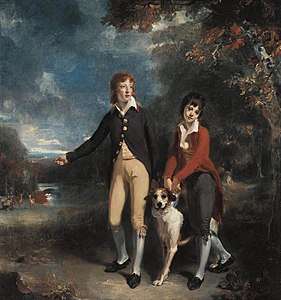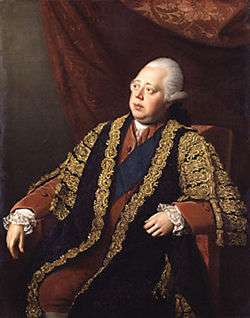William Talbot, 1st Earl Talbot
William Talbot, 1st Earl Talbot PC (16 May 1710 – 27 April 1782), known as the Lord Talbot from 1737 to 1761, was a British politician.
Life
Talbot was born at Worcester, the son of Charles Talbot, later Baron Talbot. He was educated at Eton from 1725 to 1728 and matriculated at Exeter College, Oxford on 23 January 1727. He was created DCL (Doctor of Civil Law) on 12 June 1736. He was Member of Parliament for Glamorganshire from 1734 to 1737, when he succeeded his father in the barony and entered the House of Lords. He was Lord High Steward at King George III's coronation, and became a member of the Privy Council in 1761. He served from then until his death as Lord Steward of the Household. He was created Earl Talbot on 29 March 1761.
Talbot died 27 April 1782 at Lincolns Inn Fields and was buried at Sutton.
Family

Talbot had no sons so when he was created Baron Dynevor of Dynevor in the county of Carmarthen on 17 October 1780, it was with a special remainder in favour of his only child, a daughter, and the heirs male of her body.
Talbot had married Mary, daughter and heir of Adam de Cardonnel, secretary to the Duke of Marlborough, on 21 February 1733, at St George, Hanover Square.
He had an affair with Frances Somerset, Duchess of Beaufort (born 14 August 1711 – died 16 February 1750), wife of Henry Scudamore-Somerset, 3rd Duke of Beaufort which led to the Beauforts' divorce in 1743.
Mary Anne Talbot claimed to be one of sixteen illegitimate children of Lord Talbot.[1]
At his death, the earldom became extinct, whilst the barony of Talbot passed to his nephew (and is now part of the earldom of Shrewsbury), and the barony of Dynevor to his daughter and thereafter to her eldest son. She had married George Griffiths and had two sons, the eldest of which was George Griffiths, 3rd Baron Dynevor.
References
- ↑ Talbot, M. A. (May 2006) [1809]. Royster, P., ed. "The Life and Surprising Adventures of Mary Ann Talbot, in the Name of John Taylor". University of Nebraska - Lincoln.
External links
| Parliament of Great Britain | ||
|---|---|---|
| Preceded by Sir Charles Kemys |
Member of Parliament for Glamorganshire 1734–1737 |
Succeeded by Bussy Mansell |
| Political offices | ||
| Preceded by The Duke of Rutland |
Lord Steward of the Household 1761–1782 |
Succeeded by The Earl of Carlisle |
| Peerage of Great Britain | ||
| New creation | Earl Talbot 1761–1782 |
Extinct |
| Baron Dynevor 1780–1782 |
Succeeded by Cecil Rice | |
| Preceded by Charles Talbot |
Baron Talbot 1737–1782 |
Succeeded by John Chetwynd-Talbot |
